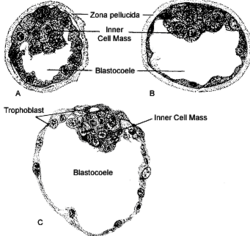
Back تجويف أريمي Arabic Бластацэль Byelorussian Бластоцел Bulgarian Blastocel Catalan Blastocoel Czech Blastocoel German Blastocele Spanish Blastozele Basque Blastocèle French Blastocele Galician
| Blastocoel | |
|---|---|
 Mammalian blastocoel | |
 Schematic diagram showing the blastocyst, with its embryoblast (inner cell mass) and its trophoblast layer, alongside the surface of the endometrium. | |
| Details | |
| Carnegie stage | 3 |
| Days | 5 |
| Precursor | Morula |
| Gives rise to | Gastrula, primitive yolk sac |
| Anatomical terminology | |
The blastocoel (/ˈblæstəˌsiːl/), also spelled blastocoele and blastocele, and also called cleavage cavity, or segmentation cavity[1] is a fluid-filled or yolk-filled cavity that forms in the blastula during very early embryonic development. At this stage in mammals the blastula is called the blastocyst, which consists of an outer epithelium, the trophectoderm, enveloping the inner cell mass and the blastocoel .
It develops following cleavage of the zygote after fertilization.[2][3] It is the first fluid-filled cavity or lumen formed as the embryo enlarges,[4] and is the essential precursor for the differentiated gastrula.[5][page needed] In the Xenopus a very small cavity has been described in the two-cell stage of development.[6]
- ^ "Definition of BLASTOCOEL". Merriam-Webster.
- ^ Biggers, JD; Borland, RM; Powers, RD (1977). "Transport Mechanisms in the Preimplantation Mammalian Embryo". Ciba Foundation Symposium 52 - the Freezing of Mammalian Embryos. Novartis Foundation Symposia. Vol. 52. pp. 129–53. doi:10.1002/9780470720332.ch7. ISBN 9780470720332. PMID 145938.
{{cite book}}:|journal=ignored (help) - ^ Kalt, Marvin R. (1971). "The relationship between cleavage and blastocoel formation in Xenopus laevis. I. Light microscopic observations". Journal of Embryology and Experimental Morphology. 26 (1): 37–49. PMID 5565077.
- ^ Heasman, Janet; Crawford, Aaron; Goldstone, Kim; Garner-Hamrick, Peggy; Gumbiner, Barry; McCrea, Pierre; Kintner, Chris; Noro, Chikako Yoshida; Wylie, Chris (1994). "Overexpression of cadherins and underexpression of β-catenin inhibit dorsal mesoderm induction in early Xenopus embryos". Cell. 79 (5): 791–803. doi:10.1016/0092-8674(94)90069-8. PMID 7528101. S2CID 33403560.
- ^ Gilbert, Scott F. (2010). Developmental biology (9th ed.). Sunderland, Mass.: Sinauer Associates. ISBN 978-0-87893-384-6.
- ^ Wolpert, Lewis (2015). Principles of development (Fifth ed.). Oxford, United Kingdom. p. 375. ISBN 9780199678143.
{{cite book}}: CS1 maint: location missing publisher (link)